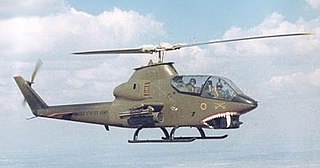
The Bell AH-1 Cobra is a single-engined attack helicopter developed and manufactured by the American rotorcraft manufacturer Bell Helicopter. A member of the prolific Huey family, the AH-1 is also referred to as the HueyCobra or Snake.

The Bell UH-1 Iroquois is a utility military helicopter designed and produced by the American aerospace company Bell Helicopter. It is the first member of the prolific Huey family, as well as the first turbine-powered helicopter in service with the United States military.

Bell Textron Inc. is an American aerospace manufacturer headquartered in Fort Worth, Texas. A subsidiary of Textron, Bell manufactures military rotorcraft at facilities in Fort Worth, and Amarillo, Texas, United States as well as commercial helicopters in Mirabel, Quebec, Canada.

The Bell AH-1 SuperCobra is a twin-engined attack helicopter that was developed on behalf of, and primarily operated by, the United States Marine Corps (USMC). The twin Cobra family, itself part of the larger Huey family, includes the AH-1J SeaCobra, the AH-1T Improved SeaCobra, and the AH-1W SuperCobra.

The Sikorsky H-34 is an American piston-engined military helicopter originally designed by Sikorsky as an anti-submarine warfare (ASW) aircraft for the United States Navy. It has seen extended use when adapted to turbine power by the British licensee as the Westland Wessex and Sikorsky as the later S-58T. This type had a variety of names depending on the role and timing, but included the aforementioned Wessex, Seahorse, Seabat, and Choctaw. Most of the H-34 (S-58) used radial aviation engines, though other powerplants were employed, and the Wessex used predominantly twin gas turbines. Individual versions often had unique names, the type including everything from the U.S. Coast Guard HH-34F Seahorse was used for search and rescue, to the commercial Winnebago Heli-Home, to Canada's CH-126, the USMC it often went by "HUS" after its original designation in that service.

Marine Light Attack Helicopter Squadron 367 (HMLA-367) is a United States Marine Corps helicopter squadron consisting of AH-1Z Viper attack helicopters and UH-1Y Venom utility helicopters. Originally commissioned during World War II, the squadron participated in combat operations on Peleliu and Okinawa. Reactivated during the Vietnam War, the squadron has served during numerous conflicts since. The squadron is based at Marine Corps Air Station Camp Pendleton, California and falls under the command of Marine Aircraft Group 39 (MAG-39) and the 3rd Marine Aircraft Wing.
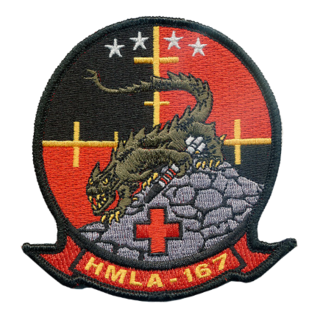
Marine Light Attack Helicopter Squadron 167 (HMLA-167) is a United States Marine Corps helicopter squadron consisting of Bell AH-1Z Viper attack helicopters and UH-1Y Venom utility helicopters. Known as the "Warriors", they are based at Marine Corps Air Station New River, North Carolina and fall under the command of Marine Aircraft Group 29 (MAG-29) and the 2nd Marine Aircraft Wing.
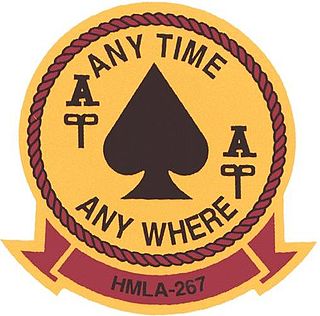
Marine Light Attack Helicopter Squadron 267 (HMLA-267) is a United States Marine Corps helicopter squadron consisting of Bell AH-1Z Viper attack helicopters and Bell UH-1Y Venom utility helicopters. Nicknamed the "Stingers", the squadron is based at Marine Corps Air Station Camp Pendleton, California and falls under the command of Marine Aircraft Group 39 (MAG-39) and the 3rd Marine Aircraft Wing.
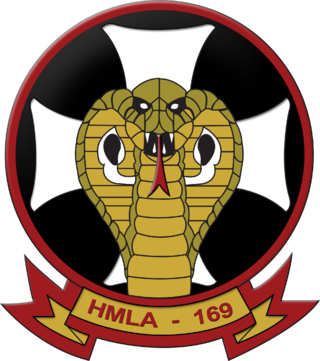
Marine Light Attack Helicopter Squadron 169 (HMLA-169) is a United States Marine Corps helicopter squadron consisting of AH-1Z Viper attack helicopters and UH-1Y Venom utility helicopters. The squadron is based at Marine Corps Air Station Camp Pendleton, California and falls under the command of Marine Aircraft Group 39 (MAG-39) and the 3rd Marine Aircraft Wing.

Marine Light Attack Helicopter Training Squadron 303 (HMLAT-303), is a United States Marine Corps helicopter training squadron stationed at Marine Corps Air Station Camp Pendleton, California. Known as "Atlas", HMLAT-303 trains newly commissioned Naval Aviators, conversion pilots, and refresher pilots to fly the Bell UH-1Y Venom and Bell AH-1Z Viper. HMLAT-303 is also responsible for training Bell UH-1Y Venom crew chiefs. It is part of Marine Aircraft Group 39 (MAG-39) and the 3rd Marine Aircraft Wing.

The EurocopterUH-72 Lakota is a twin-engine helicopter with a single, four-bladed main rotor. The UH-72 is a militarized version of the Eurocopter EC145, built by American Eurocopter, a division of Airbus Group, Inc. Several hundred UH-72 of various types have entered service by the 2020s since their introduction in 2006.
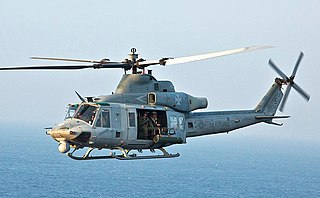
The Bell UH-1Y Venom is a twin-engine, 4-blade, medium-sized utility helicopter built by Bell Helicopter under the H-1 upgrade program of the United States Marine Corps. One of the latest members of the numerous Huey family, the UH-1Y is also called "Yankee" for the NATO phonetic alphabet pronunciation of its variant letter. Bell was originally to produce UH-1Ys by rebuilding UH-1Ns, but ultimately used new built airframes. In 2008, the UH-1Y entered service with the Marine Corps and also began full-rate production. The new UH-1 variant replaced the USMC's UH-1N Twin Huey light utility helicopters, introduced in the early 1970s. The helicopter were ordered by the Czech Republic and the helicopter is in production in the early 2020s.

Marine Corps Air Station Camp Pendleton or MCAS Camp Pendleton is a United States Marine Corps airfield located within Marine Corps Base Camp Pendleton, California. It was commissioned in 1942 and is currently home to Marine Aircraft Group 39. The airfield is also known as Munn Field in honor of Lieutenant General John C. "Toby" Munn, the first Marine aviator to serve as the Commanding General of Marine Corps Base Camp Pendleton.

The Bell 204 and 205 are the civilian versions of the UH-1 Iroquois single-engine military helicopter of the Huey family of helicopters. They are type-certificated in the transport category and are used in a wide variety of applications, including crop dusting, cargo lifting, Forestry Operations, and aerial firefighting.

The Bell UH-1N Twin Huey is a medium military helicopter designed and produced by the American aerospace manufacturer Bell Helicopter. It is a member of the extensive Huey family, the initial version was the CUH-1N Twin Huey, which was first ordered by the Canadian Forces in 1968.

The Bell AH-1Z Viper is a twin-engine attack helicopter, based on the AH-1W SuperCobra, designed and produced by the American aerospace manufacturer Bell Helicopter. It is one of the latest members of the prolific Bell Huey family. It is often called "Zulu Cobra", based on the military phonetic alphabet pronunciation of its variant letter.

The Bell UH-1 Iroquois military helicopter, first introduced in 1959, is the first production member of the prolific Huey family of helicopters, and was itself developed in over twenty variants, which are listed below.

The Bell Huey family of helicopters includes a wide range of civil and military aircraft produced since 1956 by Bell Helicopter. This H-1 family of aircraft includes the utility UH-1 Iroquois and the derivative AH-1 Cobra attack helicopter series and ranges from the XH-40 prototype, first flown in October 1956, to the 21st-century UH-1Y Venom and AH-1Z Viper. Although not flown in military service in the USA, the Bell 412 served in Canada and Japan and, like the UH-1Y, is a twin engine four rotor design based on the Bell 212.
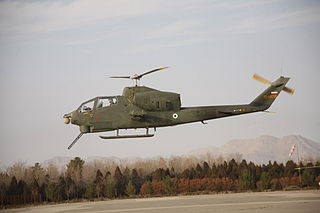
The IAIO Toufan or Toophan is series of combat helicopters by the Iran Aviation Industries Organization. Based on the US-built AH-1J SeaCobra, the Toufan has two variants, the Toufan I unveiled in May 2010 and the improved Toufan II unveiled in January 2013.



























